Analyzing Leadership and Management Strategies for PM Company - Report
VerifiedAdded on 2020/02/14
|13
|4208
|37
Report
AI Summary
This report provides a comprehensive analysis of leadership and management practices within PM Company, a UK-based courier firm facing significant challenges. The report delves into the importance of effective recruitment and selection processes, detailing necessary documentation and legal/ethical considerations. It evaluates the selection process and the role of a CEO in this process. The report examines essential leadership skills and attributes, differentiating between leadership and management, and explores various leadership styles adaptable to different situations within the company. Furthermore, it discusses strategies for motivating staff, including remuneration and recognition. The report also addresses team-working benefits and performance assessment, including planning, monitoring, and evaluating work performance, and the development needs of individuals within the organization. The report provides a detailed overview of leadership challenges, management strategies, and recommendations for PM Company to improve its operational efficiency and employee satisfaction. The report is focused on how to improve the leadership qualities in the PM company.

Working with and leading
people
1
people
1
Paraphrase This Document
Need a fresh take? Get an instant paraphrase of this document with our AI Paraphraser
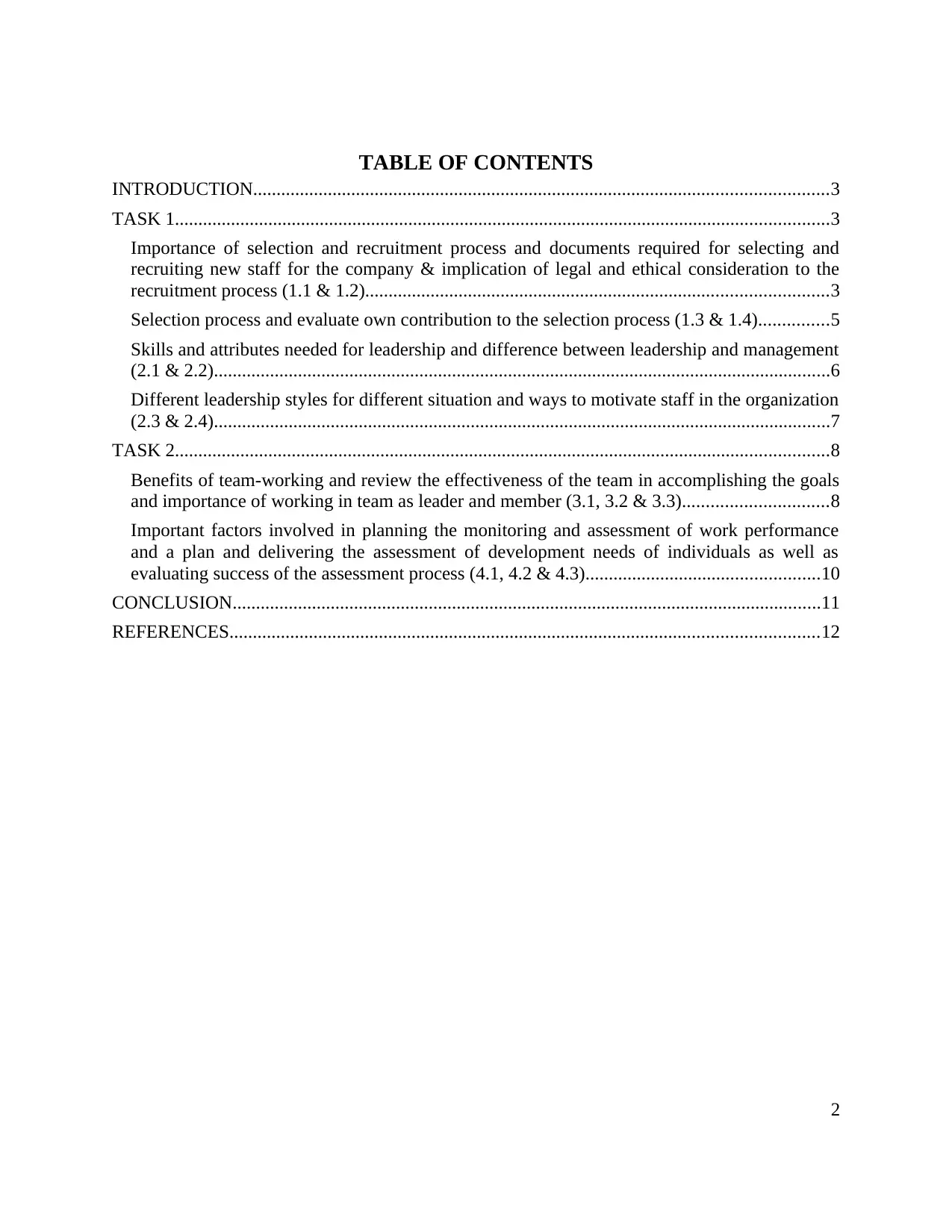
TABLE OF CONTENTS
INTRODUCTION...........................................................................................................................3
TASK 1............................................................................................................................................3
Importance of selection and recruitment process and documents required for selecting and
recruiting new staff for the company & implication of legal and ethical consideration to the
recruitment process (1.1 & 1.2)...................................................................................................3
Selection process and evaluate own contribution to the selection process (1.3 & 1.4)...............5
Skills and attributes needed for leadership and difference between leadership and management
(2.1 & 2.2)....................................................................................................................................6
Different leadership styles for different situation and ways to motivate staff in the organization
(2.3 & 2.4)....................................................................................................................................7
TASK 2............................................................................................................................................8
Benefits of team-working and review the effectiveness of the team in accomplishing the goals
and importance of working in team as leader and member (3.1, 3.2 & 3.3)...............................8
Important factors involved in planning the monitoring and assessment of work performance
and a plan and delivering the assessment of development needs of individuals as well as
evaluating success of the assessment process (4.1, 4.2 & 4.3)..................................................10
CONCLUSION..............................................................................................................................11
REFERENCES..............................................................................................................................12
2
INTRODUCTION...........................................................................................................................3
TASK 1............................................................................................................................................3
Importance of selection and recruitment process and documents required for selecting and
recruiting new staff for the company & implication of legal and ethical consideration to the
recruitment process (1.1 & 1.2)...................................................................................................3
Selection process and evaluate own contribution to the selection process (1.3 & 1.4)...............5
Skills and attributes needed for leadership and difference between leadership and management
(2.1 & 2.2)....................................................................................................................................6
Different leadership styles for different situation and ways to motivate staff in the organization
(2.3 & 2.4)....................................................................................................................................7
TASK 2............................................................................................................................................8
Benefits of team-working and review the effectiveness of the team in accomplishing the goals
and importance of working in team as leader and member (3.1, 3.2 & 3.3)...............................8
Important factors involved in planning the monitoring and assessment of work performance
and a plan and delivering the assessment of development needs of individuals as well as
evaluating success of the assessment process (4.1, 4.2 & 4.3)..................................................10
CONCLUSION..............................................................................................................................11
REFERENCES..............................................................................................................................12
2

INTRODUCTION
Leadership is described as the process that influences the individual and direct them
towards attaining the specific goals ad objectives of the firm (Selznick, 2011). Therefore, it is
essential for the organization to manage and lead employees within the organization so that they
should easily accomplish goals with satisfying their needs and requirement. The present report
focuses on the case study of PM company one of the largest courier firms in UK that currently
faces leadership and management problems. However, the report will also understand the
different style of leadership and their impact on the different situation. Furthermore the report
will also focus on assessing the development needs of the individuals.
TASK 1
Importance of selection and recruitment process and documents required for selecting and
recruiting new staff for the company & implication of legal and ethical consideration to the
recruitment process (1.1 & 1.2)
For performing the tasks and activities efficaciously PM company should focus on the
effective process of recruitment and selection so that they can appoint the new and competent
staff within the organization (Spillane, 2012). With the current situation of PM company the
administrative department and process of recruitment and selection is consider as very poor that
primarily result in senior manager and other 100 staff left the company. However, the
recruitment and selection process have signification impact on the organization as proper and
effective recruitment of personnel in the PM company will result in delivering courier in the
adequate time period without any delay. Another importance of selection and recruitment
process is that effective process reduces and minimizes the employee turnover that result in
gaining and improving the productivity of the organization (Lussier and Achua, 2015).
According to the case scenario, PM company faces leadership, management and
administration problem that results in making losses for some year. Therefore, for improving the
management sand standard of the company CEO focus on recruiting new staff that is drivers for
the company so that they can easily accomplish the goals and overcome the losses (Johnson,
2013). The different documentation that is being required while recruiting and selecting the new
3
Leadership is described as the process that influences the individual and direct them
towards attaining the specific goals ad objectives of the firm (Selznick, 2011). Therefore, it is
essential for the organization to manage and lead employees within the organization so that they
should easily accomplish goals with satisfying their needs and requirement. The present report
focuses on the case study of PM company one of the largest courier firms in UK that currently
faces leadership and management problems. However, the report will also understand the
different style of leadership and their impact on the different situation. Furthermore the report
will also focus on assessing the development needs of the individuals.
TASK 1
Importance of selection and recruitment process and documents required for selecting and
recruiting new staff for the company & implication of legal and ethical consideration to the
recruitment process (1.1 & 1.2)
For performing the tasks and activities efficaciously PM company should focus on the
effective process of recruitment and selection so that they can appoint the new and competent
staff within the organization (Spillane, 2012). With the current situation of PM company the
administrative department and process of recruitment and selection is consider as very poor that
primarily result in senior manager and other 100 staff left the company. However, the
recruitment and selection process have signification impact on the organization as proper and
effective recruitment of personnel in the PM company will result in delivering courier in the
adequate time period without any delay. Another importance of selection and recruitment
process is that effective process reduces and minimizes the employee turnover that result in
gaining and improving the productivity of the organization (Lussier and Achua, 2015).
According to the case scenario, PM company faces leadership, management and
administration problem that results in making losses for some year. Therefore, for improving the
management sand standard of the company CEO focus on recruiting new staff that is drivers for
the company so that they can easily accomplish the goals and overcome the losses (Johnson,
2013). The different documentation that is being required while recruiting and selecting the new
3
⊘ This is a preview!⊘
Do you want full access?
Subscribe today to unlock all pages.

Trusted by 1+ million students worldwide

staff for the company include job description and person specification that would support CEO in
selecting the qualified personnel and staff for the firm.
Vacancy: 40 Drivers
Job Description
Job Title- Drivers
Reporting Authority- Manager
Duties & Responsibilities-
Foremost duty is to drive safely and timely deliver the package to the ultimate
customers.
There duty is to load and unload the packages and courier and to keep log of the
activities that they perform (Ulrich, Zenger and Smallwood, 2013).
There duty is to ensure proper maintenance of the vehicle that they are driving.
There responsibility is to maintain professionalism while delivering the courier to
customers.
Working Hour- Part time
Full time
In order to enable effectual recruitment and selection process within PM company CEO
will focus on different legal and ethical consideration that would ensure ethical process for
selecting and recruiting the personnel (George, 2010). There are different legal and regulatory
framework enforced by the UK government so that PM company can ensure impressive
recruitment and selection process. The implication of different act to the process results in-1. Equality act: This act framed by the UK government is constitutional for the PM
company so that CEO while selecting the new staff should maintain equality among the
candidate who have been enlisted for the vacant posts. Therefore, Equality act must be
enforced within the company policy that would support the CEO in selecting the
competent and qualified candidate (Leithwood, Chapman and Corson, 2012). The
implication of equality act would be that it result in selecting the suitable worker for the
company.
4
selecting the qualified personnel and staff for the firm.
Vacancy: 40 Drivers
Job Description
Job Title- Drivers
Reporting Authority- Manager
Duties & Responsibilities-
Foremost duty is to drive safely and timely deliver the package to the ultimate
customers.
There duty is to load and unload the packages and courier and to keep log of the
activities that they perform (Ulrich, Zenger and Smallwood, 2013).
There duty is to ensure proper maintenance of the vehicle that they are driving.
There responsibility is to maintain professionalism while delivering the courier to
customers.
Working Hour- Part time
Full time
In order to enable effectual recruitment and selection process within PM company CEO
will focus on different legal and ethical consideration that would ensure ethical process for
selecting and recruiting the personnel (George, 2010). There are different legal and regulatory
framework enforced by the UK government so that PM company can ensure impressive
recruitment and selection process. The implication of different act to the process results in-1. Equality act: This act framed by the UK government is constitutional for the PM
company so that CEO while selecting the new staff should maintain equality among the
candidate who have been enlisted for the vacant posts. Therefore, Equality act must be
enforced within the company policy that would support the CEO in selecting the
competent and qualified candidate (Leithwood, Chapman and Corson, 2012). The
implication of equality act would be that it result in selecting the suitable worker for the
company.
4
Paraphrase This Document
Need a fresh take? Get an instant paraphrase of this document with our AI Paraphraser
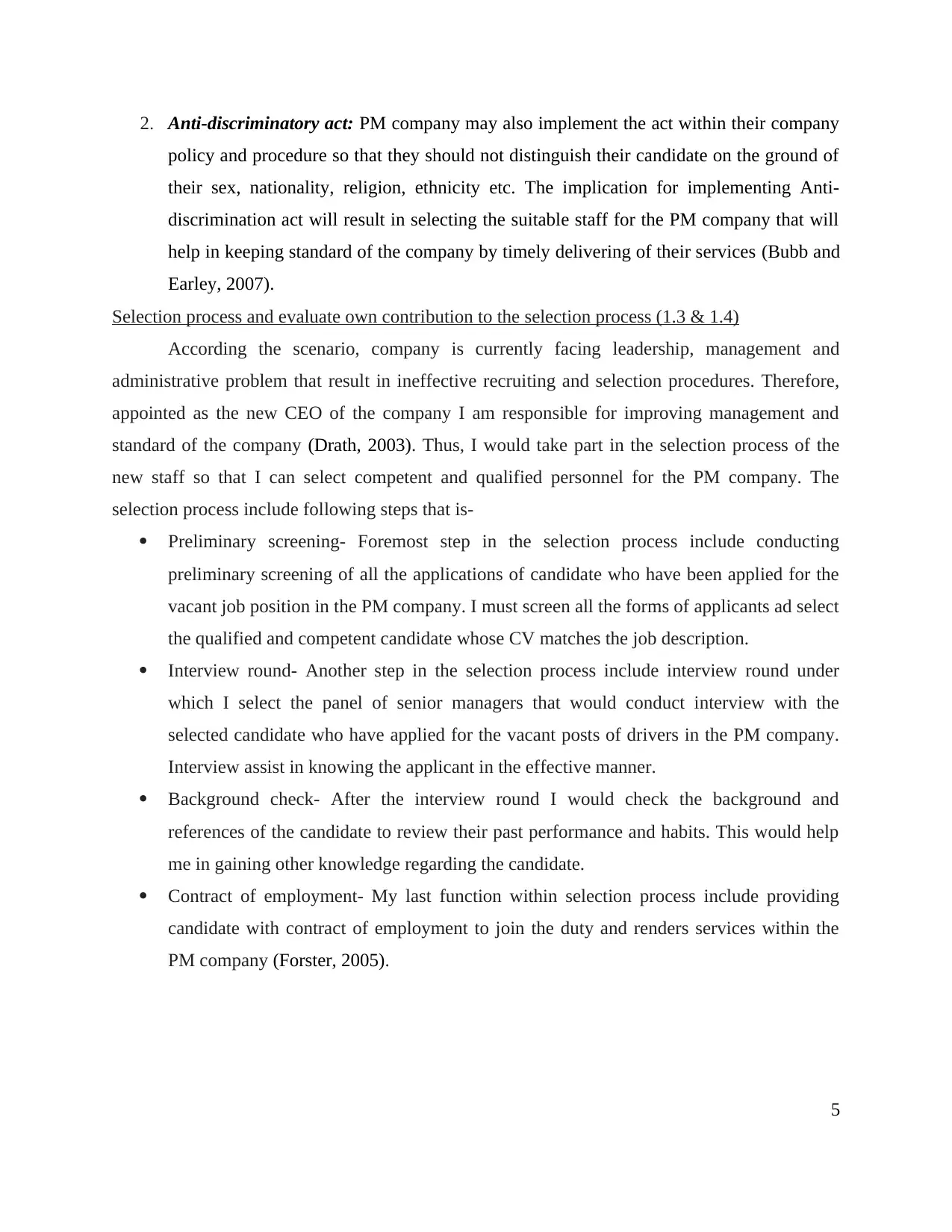
2. Anti-discriminatory act: PM company may also implement the act within their company
policy and procedure so that they should not distinguish their candidate on the ground of
their sex, nationality, religion, ethnicity etc. The implication for implementing Anti-
discrimination act will result in selecting the suitable staff for the PM company that will
help in keeping standard of the company by timely delivering of their services (Bubb and
Earley, 2007).
Selection process and evaluate own contribution to the selection process (1.3 & 1.4)
According the scenario, company is currently facing leadership, management and
administrative problem that result in ineffective recruiting and selection procedures. Therefore,
appointed as the new CEO of the company I am responsible for improving management and
standard of the company (Drath, 2003). Thus, I would take part in the selection process of the
new staff so that I can select competent and qualified personnel for the PM company. The
selection process include following steps that is-
Preliminary screening- Foremost step in the selection process include conducting
preliminary screening of all the applications of candidate who have been applied for the
vacant job position in the PM company. I must screen all the forms of applicants ad select
the qualified and competent candidate whose CV matches the job description.
Interview round- Another step in the selection process include interview round under
which I select the panel of senior managers that would conduct interview with the
selected candidate who have applied for the vacant posts of drivers in the PM company.
Interview assist in knowing the applicant in the effective manner.
Background check- After the interview round I would check the background and
references of the candidate to review their past performance and habits. This would help
me in gaining other knowledge regarding the candidate.
Contract of employment- My last function within selection process include providing
candidate with contract of employment to join the duty and renders services within the
PM company (Forster, 2005).
5
policy and procedure so that they should not distinguish their candidate on the ground of
their sex, nationality, religion, ethnicity etc. The implication for implementing Anti-
discrimination act will result in selecting the suitable staff for the PM company that will
help in keeping standard of the company by timely delivering of their services (Bubb and
Earley, 2007).
Selection process and evaluate own contribution to the selection process (1.3 & 1.4)
According the scenario, company is currently facing leadership, management and
administrative problem that result in ineffective recruiting and selection procedures. Therefore,
appointed as the new CEO of the company I am responsible for improving management and
standard of the company (Drath, 2003). Thus, I would take part in the selection process of the
new staff so that I can select competent and qualified personnel for the PM company. The
selection process include following steps that is-
Preliminary screening- Foremost step in the selection process include conducting
preliminary screening of all the applications of candidate who have been applied for the
vacant job position in the PM company. I must screen all the forms of applicants ad select
the qualified and competent candidate whose CV matches the job description.
Interview round- Another step in the selection process include interview round under
which I select the panel of senior managers that would conduct interview with the
selected candidate who have applied for the vacant posts of drivers in the PM company.
Interview assist in knowing the applicant in the effective manner.
Background check- After the interview round I would check the background and
references of the candidate to review their past performance and habits. This would help
me in gaining other knowledge regarding the candidate.
Contract of employment- My last function within selection process include providing
candidate with contract of employment to join the duty and renders services within the
PM company (Forster, 2005).
5
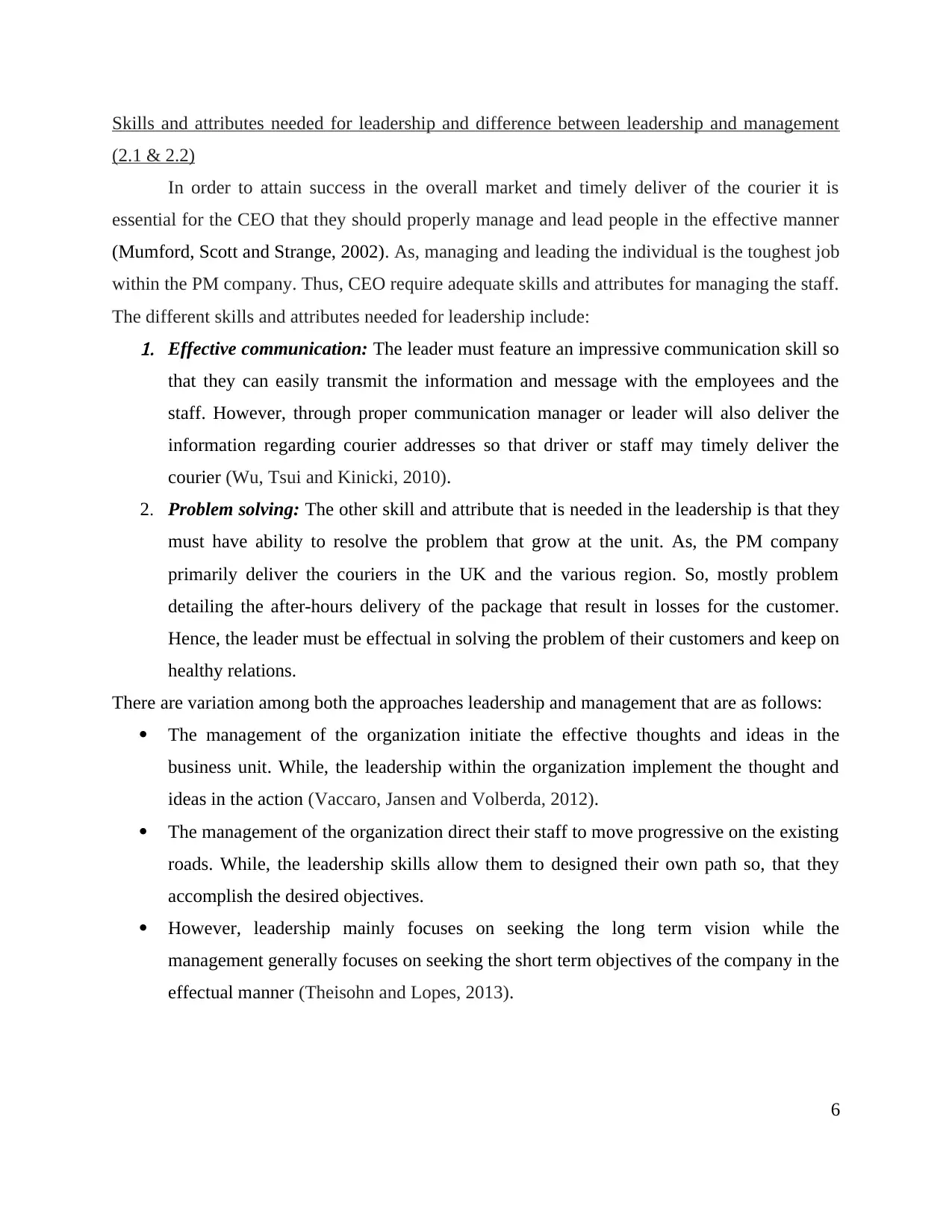
Skills and attributes needed for leadership and difference between leadership and management
(2.1 & 2.2)
In order to attain success in the overall market and timely deliver of the courier it is
essential for the CEO that they should properly manage and lead people in the effective manner
(Mumford, Scott and Strange, 2002). As, managing and leading the individual is the toughest job
within the PM company. Thus, CEO require adequate skills and attributes for managing the staff.
The different skills and attributes needed for leadership include:1. Effective communication: The leader must feature an impressive communication skill so
that they can easily transmit the information and message with the employees and the
staff. However, through proper communication manager or leader will also deliver the
information regarding courier addresses so that driver or staff may timely deliver the
courier (Wu, Tsui and Kinicki, 2010).
2. Problem solving: The other skill and attribute that is needed in the leadership is that they
must have ability to resolve the problem that grow at the unit. As, the PM company
primarily deliver the couriers in the UK and the various region. So, mostly problem
detailing the after-hours delivery of the package that result in losses for the customer.
Hence, the leader must be effectual in solving the problem of their customers and keep on
healthy relations.
There are variation among both the approaches leadership and management that are as follows:
The management of the organization initiate the effective thoughts and ideas in the
business unit. While, the leadership within the organization implement the thought and
ideas in the action (Vaccaro, Jansen and Volberda, 2012).
The management of the organization direct their staff to move progressive on the existing
roads. While, the leadership skills allow them to designed their own path so, that they
accomplish the desired objectives.
However, leadership mainly focuses on seeking the long term vision while the
management generally focuses on seeking the short term objectives of the company in the
effectual manner (Theisohn and Lopes, 2013).
6
(2.1 & 2.2)
In order to attain success in the overall market and timely deliver of the courier it is
essential for the CEO that they should properly manage and lead people in the effective manner
(Mumford, Scott and Strange, 2002). As, managing and leading the individual is the toughest job
within the PM company. Thus, CEO require adequate skills and attributes for managing the staff.
The different skills and attributes needed for leadership include:1. Effective communication: The leader must feature an impressive communication skill so
that they can easily transmit the information and message with the employees and the
staff. However, through proper communication manager or leader will also deliver the
information regarding courier addresses so that driver or staff may timely deliver the
courier (Wu, Tsui and Kinicki, 2010).
2. Problem solving: The other skill and attribute that is needed in the leadership is that they
must have ability to resolve the problem that grow at the unit. As, the PM company
primarily deliver the couriers in the UK and the various region. So, mostly problem
detailing the after-hours delivery of the package that result in losses for the customer.
Hence, the leader must be effectual in solving the problem of their customers and keep on
healthy relations.
There are variation among both the approaches leadership and management that are as follows:
The management of the organization initiate the effective thoughts and ideas in the
business unit. While, the leadership within the organization implement the thought and
ideas in the action (Vaccaro, Jansen and Volberda, 2012).
The management of the organization direct their staff to move progressive on the existing
roads. While, the leadership skills allow them to designed their own path so, that they
accomplish the desired objectives.
However, leadership mainly focuses on seeking the long term vision while the
management generally focuses on seeking the short term objectives of the company in the
effectual manner (Theisohn and Lopes, 2013).
6
⊘ This is a preview!⊘
Do you want full access?
Subscribe today to unlock all pages.

Trusted by 1+ million students worldwide
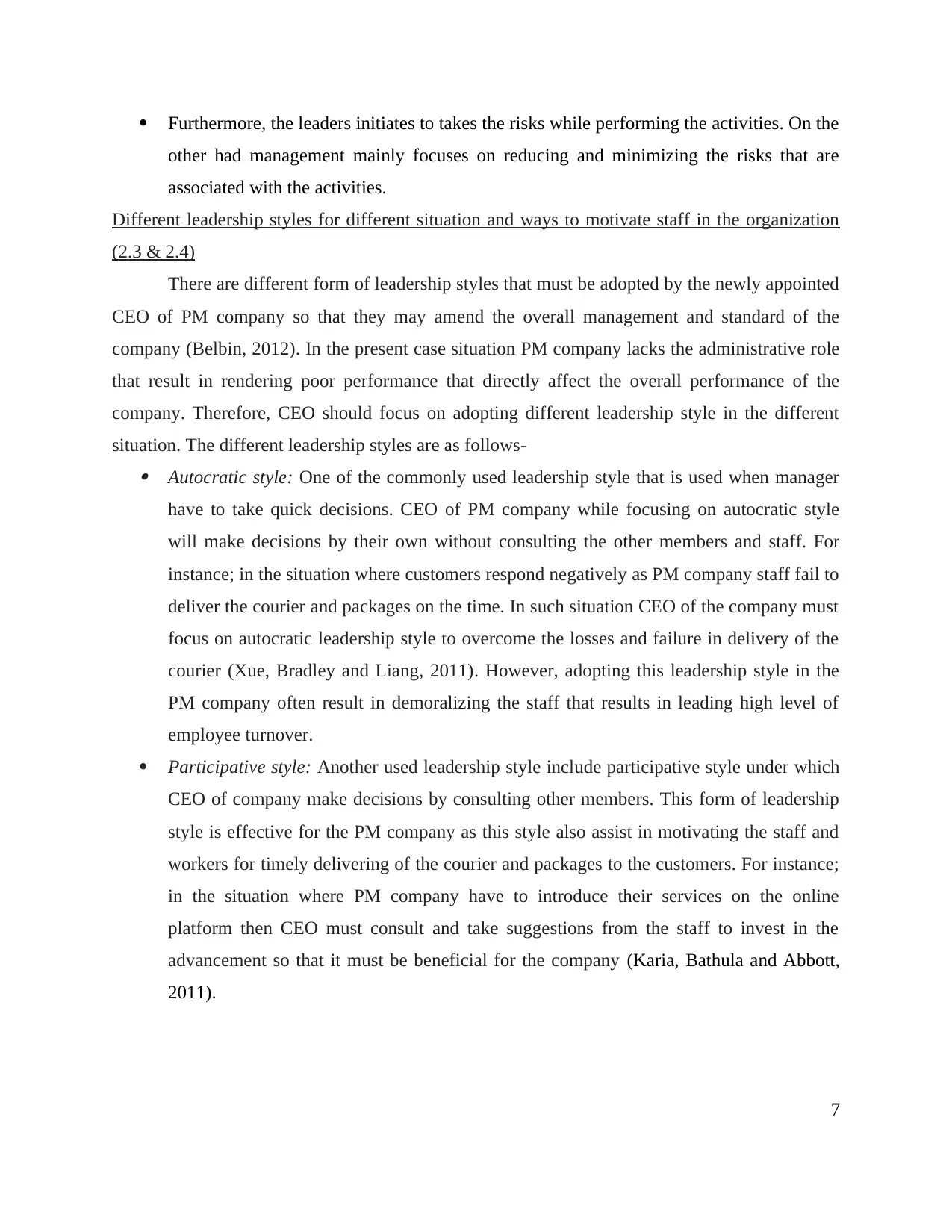
Furthermore, the leaders initiates to takes the risks while performing the activities. On the
other had management mainly focuses on reducing and minimizing the risks that are
associated with the activities.
Different leadership styles for different situation and ways to motivate staff in the organization
(2.3 & 2.4)
There are different form of leadership styles that must be adopted by the newly appointed
CEO of PM company so that they may amend the overall management and standard of the
company (Belbin, 2012). In the present case situation PM company lacks the administrative role
that result in rendering poor performance that directly affect the overall performance of the
company. Therefore, CEO should focus on adopting different leadership style in the different
situation. The different leadership styles are as follows- Autocratic style: One of the commonly used leadership style that is used when manager
have to take quick decisions. CEO of PM company while focusing on autocratic style
will make decisions by their own without consulting the other members and staff. For
instance; in the situation where customers respond negatively as PM company staff fail to
deliver the courier and packages on the time. In such situation CEO of the company must
focus on autocratic leadership style to overcome the losses and failure in delivery of the
courier (Xue, Bradley and Liang, 2011). However, adopting this leadership style in the
PM company often result in demoralizing the staff that results in leading high level of
employee turnover.
Participative style: Another used leadership style include participative style under which
CEO of company make decisions by consulting other members. This form of leadership
style is effective for the PM company as this style also assist in motivating the staff and
workers for timely delivering of the courier and packages to the customers. For instance;
in the situation where PM company have to introduce their services on the online
platform then CEO must consult and take suggestions from the staff to invest in the
advancement so that it must be beneficial for the company (Karia, Bathula and Abbott,
2011).
7
other had management mainly focuses on reducing and minimizing the risks that are
associated with the activities.
Different leadership styles for different situation and ways to motivate staff in the organization
(2.3 & 2.4)
There are different form of leadership styles that must be adopted by the newly appointed
CEO of PM company so that they may amend the overall management and standard of the
company (Belbin, 2012). In the present case situation PM company lacks the administrative role
that result in rendering poor performance that directly affect the overall performance of the
company. Therefore, CEO should focus on adopting different leadership style in the different
situation. The different leadership styles are as follows- Autocratic style: One of the commonly used leadership style that is used when manager
have to take quick decisions. CEO of PM company while focusing on autocratic style
will make decisions by their own without consulting the other members and staff. For
instance; in the situation where customers respond negatively as PM company staff fail to
deliver the courier and packages on the time. In such situation CEO of the company must
focus on autocratic leadership style to overcome the losses and failure in delivery of the
courier (Xue, Bradley and Liang, 2011). However, adopting this leadership style in the
PM company often result in demoralizing the staff that results in leading high level of
employee turnover.
Participative style: Another used leadership style include participative style under which
CEO of company make decisions by consulting other members. This form of leadership
style is effective for the PM company as this style also assist in motivating the staff and
workers for timely delivering of the courier and packages to the customers. For instance;
in the situation where PM company have to introduce their services on the online
platform then CEO must consult and take suggestions from the staff to invest in the
advancement so that it must be beneficial for the company (Karia, Bathula and Abbott,
2011).
7
Paraphrase This Document
Need a fresh take? Get an instant paraphrase of this document with our AI Paraphraser
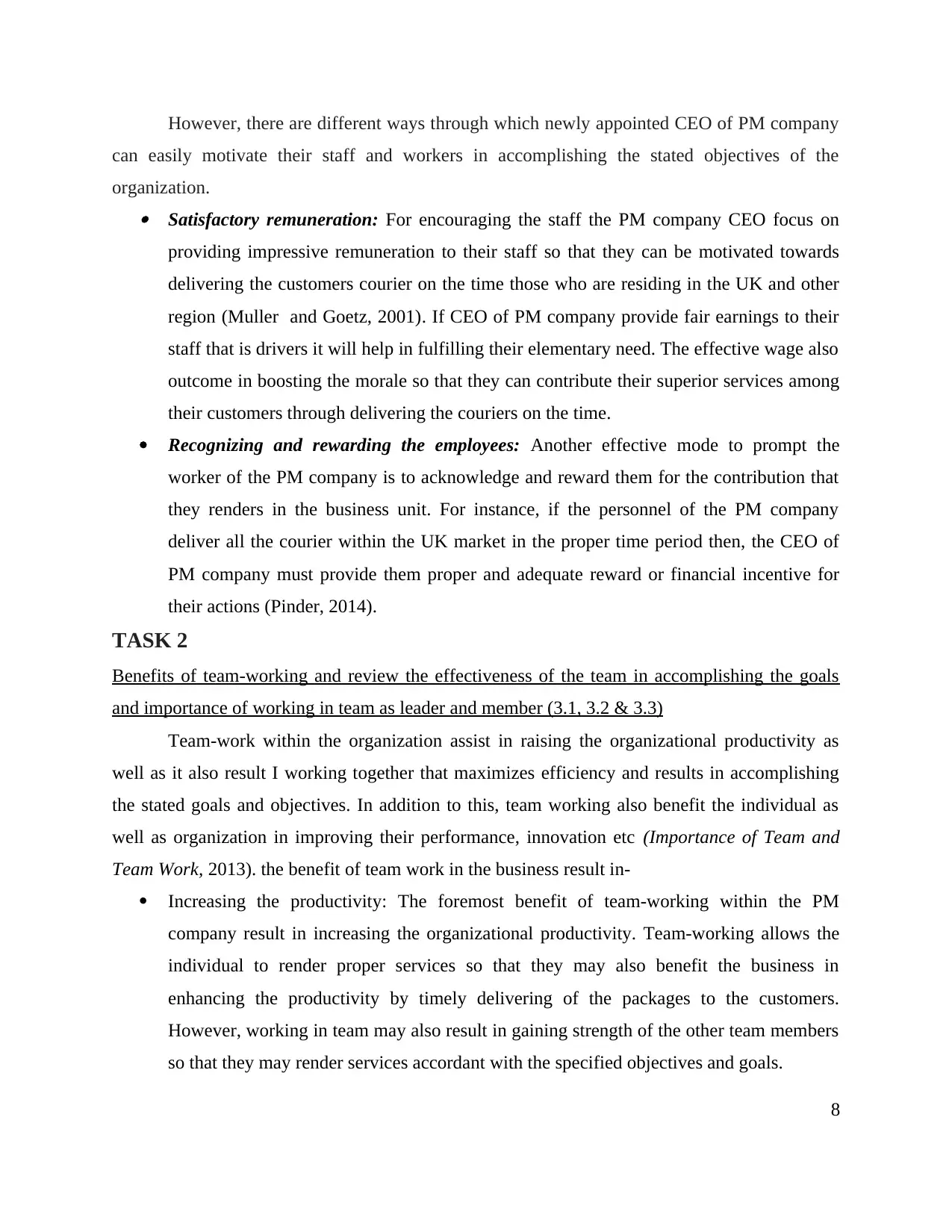
However, there are different ways through which newly appointed CEO of PM company
can easily motivate their staff and workers in accomplishing the stated objectives of the
organization. Satisfactory remuneration: For encouraging the staff the PM company CEO focus on
providing impressive remuneration to their staff so that they can be motivated towards
delivering the customers courier on the time those who are residing in the UK and other
region (Muller and Goetz, 2001). If CEO of PM company provide fair earnings to their
staff that is drivers it will help in fulfilling their elementary need. The effective wage also
outcome in boosting the morale so that they can contribute their superior services among
their customers through delivering the couriers on the time.
Recognizing and rewarding the employees: Another effective mode to prompt the
worker of the PM company is to acknowledge and reward them for the contribution that
they renders in the business unit. For instance, if the personnel of the PM company
deliver all the courier within the UK market in the proper time period then, the CEO of
PM company must provide them proper and adequate reward or financial incentive for
their actions (Pinder, 2014).
TASK 2
Benefits of team-working and review the effectiveness of the team in accomplishing the goals
and importance of working in team as leader and member (3.1, 3.2 & 3.3)
Team-work within the organization assist in raising the organizational productivity as
well as it also result I working together that maximizes efficiency and results in accomplishing
the stated goals and objectives. In addition to this, team working also benefit the individual as
well as organization in improving their performance, innovation etc (Importance of Team and
Team Work, 2013). the benefit of team work in the business result in-
Increasing the productivity: The foremost benefit of team-working within the PM
company result in increasing the organizational productivity. Team-working allows the
individual to render proper services so that they may also benefit the business in
enhancing the productivity by timely delivering of the packages to the customers.
However, working in team may also result in gaining strength of the other team members
so that they may render services accordant with the specified objectives and goals.
8
can easily motivate their staff and workers in accomplishing the stated objectives of the
organization. Satisfactory remuneration: For encouraging the staff the PM company CEO focus on
providing impressive remuneration to their staff so that they can be motivated towards
delivering the customers courier on the time those who are residing in the UK and other
region (Muller and Goetz, 2001). If CEO of PM company provide fair earnings to their
staff that is drivers it will help in fulfilling their elementary need. The effective wage also
outcome in boosting the morale so that they can contribute their superior services among
their customers through delivering the couriers on the time.
Recognizing and rewarding the employees: Another effective mode to prompt the
worker of the PM company is to acknowledge and reward them for the contribution that
they renders in the business unit. For instance, if the personnel of the PM company
deliver all the courier within the UK market in the proper time period then, the CEO of
PM company must provide them proper and adequate reward or financial incentive for
their actions (Pinder, 2014).
TASK 2
Benefits of team-working and review the effectiveness of the team in accomplishing the goals
and importance of working in team as leader and member (3.1, 3.2 & 3.3)
Team-work within the organization assist in raising the organizational productivity as
well as it also result I working together that maximizes efficiency and results in accomplishing
the stated goals and objectives. In addition to this, team working also benefit the individual as
well as organization in improving their performance, innovation etc (Importance of Team and
Team Work, 2013). the benefit of team work in the business result in-
Increasing the productivity: The foremost benefit of team-working within the PM
company result in increasing the organizational productivity. Team-working allows the
individual to render proper services so that they may also benefit the business in
enhancing the productivity by timely delivering of the packages to the customers.
However, working in team may also result in gaining strength of the other team members
so that they may render services accordant with the specified objectives and goals.
8
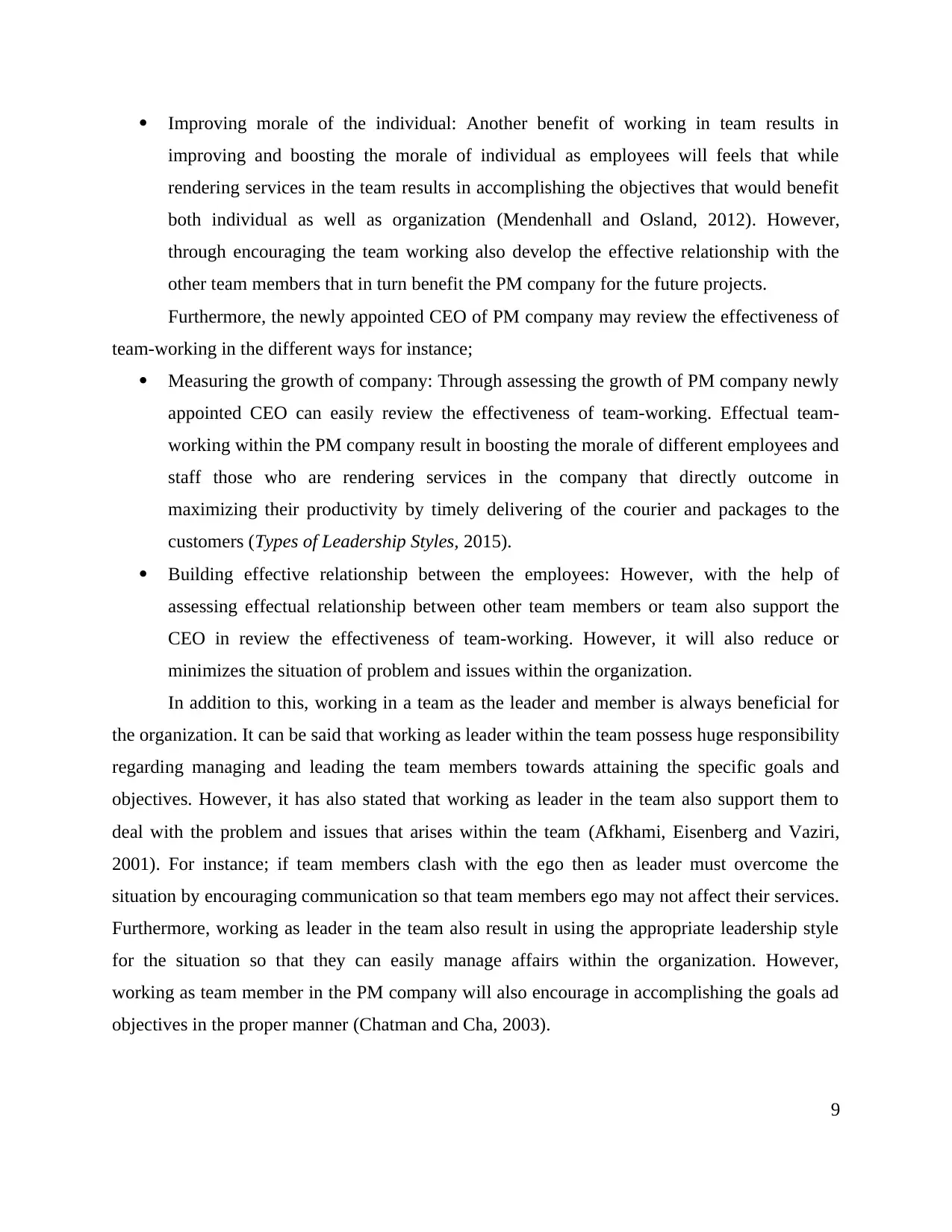
Improving morale of the individual: Another benefit of working in team results in
improving and boosting the morale of individual as employees will feels that while
rendering services in the team results in accomplishing the objectives that would benefit
both individual as well as organization (Mendenhall and Osland, 2012). However,
through encouraging the team working also develop the effective relationship with the
other team members that in turn benefit the PM company for the future projects.
Furthermore, the newly appointed CEO of PM company may review the effectiveness of
team-working in the different ways for instance;
Measuring the growth of company: Through assessing the growth of PM company newly
appointed CEO can easily review the effectiveness of team-working. Effectual team-
working within the PM company result in boosting the morale of different employees and
staff those who are rendering services in the company that directly outcome in
maximizing their productivity by timely delivering of the courier and packages to the
customers (Types of Leadership Styles, 2015).
Building effective relationship between the employees: However, with the help of
assessing effectual relationship between other team members or team also support the
CEO in review the effectiveness of team-working. However, it will also reduce or
minimizes the situation of problem and issues within the organization.
In addition to this, working in a team as the leader and member is always beneficial for
the organization. It can be said that working as leader within the team possess huge responsibility
regarding managing and leading the team members towards attaining the specific goals and
objectives. However, it has also stated that working as leader in the team also support them to
deal with the problem and issues that arises within the team (Afkhami, Eisenberg and Vaziri,
2001). For instance; if team members clash with the ego then as leader must overcome the
situation by encouraging communication so that team members ego may not affect their services.
Furthermore, working as leader in the team also result in using the appropriate leadership style
for the situation so that they can easily manage affairs within the organization. However,
working as team member in the PM company will also encourage in accomplishing the goals ad
objectives in the proper manner (Chatman and Cha, 2003).
9
improving and boosting the morale of individual as employees will feels that while
rendering services in the team results in accomplishing the objectives that would benefit
both individual as well as organization (Mendenhall and Osland, 2012). However,
through encouraging the team working also develop the effective relationship with the
other team members that in turn benefit the PM company for the future projects.
Furthermore, the newly appointed CEO of PM company may review the effectiveness of
team-working in the different ways for instance;
Measuring the growth of company: Through assessing the growth of PM company newly
appointed CEO can easily review the effectiveness of team-working. Effectual team-
working within the PM company result in boosting the morale of different employees and
staff those who are rendering services in the company that directly outcome in
maximizing their productivity by timely delivering of the courier and packages to the
customers (Types of Leadership Styles, 2015).
Building effective relationship between the employees: However, with the help of
assessing effectual relationship between other team members or team also support the
CEO in review the effectiveness of team-working. However, it will also reduce or
minimizes the situation of problem and issues within the organization.
In addition to this, working in a team as the leader and member is always beneficial for
the organization. It can be said that working as leader within the team possess huge responsibility
regarding managing and leading the team members towards attaining the specific goals and
objectives. However, it has also stated that working as leader in the team also support them to
deal with the problem and issues that arises within the team (Afkhami, Eisenberg and Vaziri,
2001). For instance; if team members clash with the ego then as leader must overcome the
situation by encouraging communication so that team members ego may not affect their services.
Furthermore, working as leader in the team also result in using the appropriate leadership style
for the situation so that they can easily manage affairs within the organization. However,
working as team member in the PM company will also encourage in accomplishing the goals ad
objectives in the proper manner (Chatman and Cha, 2003).
9
⊘ This is a preview!⊘
Do you want full access?
Subscribe today to unlock all pages.

Trusted by 1+ million students worldwide
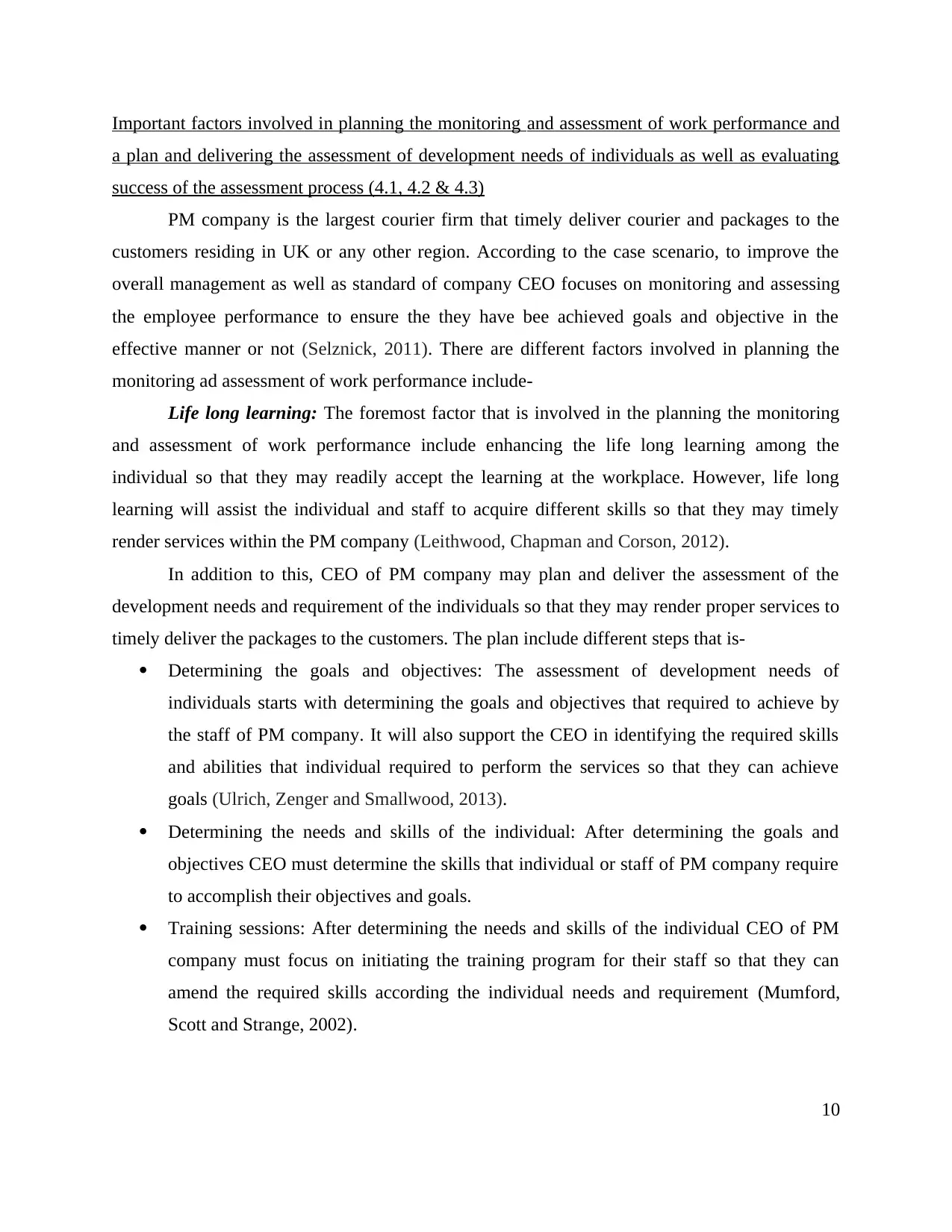
Important factors involved in planning the monitoring and assessment of work performance and
a plan and delivering the assessment of development needs of individuals as well as evaluating
success of the assessment process (4.1, 4.2 & 4.3)
PM company is the largest courier firm that timely deliver courier and packages to the
customers residing in UK or any other region. According to the case scenario, to improve the
overall management as well as standard of company CEO focuses on monitoring and assessing
the employee performance to ensure the they have bee achieved goals and objective in the
effective manner or not (Selznick, 2011). There are different factors involved in planning the
monitoring ad assessment of work performance include-
Life long learning: The foremost factor that is involved in the planning the monitoring
and assessment of work performance include enhancing the life long learning among the
individual so that they may readily accept the learning at the workplace. However, life long
learning will assist the individual and staff to acquire different skills so that they may timely
render services within the PM company (Leithwood, Chapman and Corson, 2012).
In addition to this, CEO of PM company may plan and deliver the assessment of the
development needs and requirement of the individuals so that they may render proper services to
timely deliver the packages to the customers. The plan include different steps that is-
Determining the goals and objectives: The assessment of development needs of
individuals starts with determining the goals and objectives that required to achieve by
the staff of PM company. It will also support the CEO in identifying the required skills
and abilities that individual required to perform the services so that they can achieve
goals (Ulrich, Zenger and Smallwood, 2013).
Determining the needs and skills of the individual: After determining the goals and
objectives CEO must determine the skills that individual or staff of PM company require
to accomplish their objectives and goals.
Training sessions: After determining the needs and skills of the individual CEO of PM
company must focus on initiating the training program for their staff so that they can
amend the required skills according the individual needs and requirement (Mumford,
Scott and Strange, 2002).
10
a plan and delivering the assessment of development needs of individuals as well as evaluating
success of the assessment process (4.1, 4.2 & 4.3)
PM company is the largest courier firm that timely deliver courier and packages to the
customers residing in UK or any other region. According to the case scenario, to improve the
overall management as well as standard of company CEO focuses on monitoring and assessing
the employee performance to ensure the they have bee achieved goals and objective in the
effective manner or not (Selznick, 2011). There are different factors involved in planning the
monitoring ad assessment of work performance include-
Life long learning: The foremost factor that is involved in the planning the monitoring
and assessment of work performance include enhancing the life long learning among the
individual so that they may readily accept the learning at the workplace. However, life long
learning will assist the individual and staff to acquire different skills so that they may timely
render services within the PM company (Leithwood, Chapman and Corson, 2012).
In addition to this, CEO of PM company may plan and deliver the assessment of the
development needs and requirement of the individuals so that they may render proper services to
timely deliver the packages to the customers. The plan include different steps that is-
Determining the goals and objectives: The assessment of development needs of
individuals starts with determining the goals and objectives that required to achieve by
the staff of PM company. It will also support the CEO in identifying the required skills
and abilities that individual required to perform the services so that they can achieve
goals (Ulrich, Zenger and Smallwood, 2013).
Determining the needs and skills of the individual: After determining the goals and
objectives CEO must determine the skills that individual or staff of PM company require
to accomplish their objectives and goals.
Training sessions: After determining the needs and skills of the individual CEO of PM
company must focus on initiating the training program for their staff so that they can
amend the required skills according the individual needs and requirement (Mumford,
Scott and Strange, 2002).
10
Paraphrase This Document
Need a fresh take? Get an instant paraphrase of this document with our AI Paraphraser
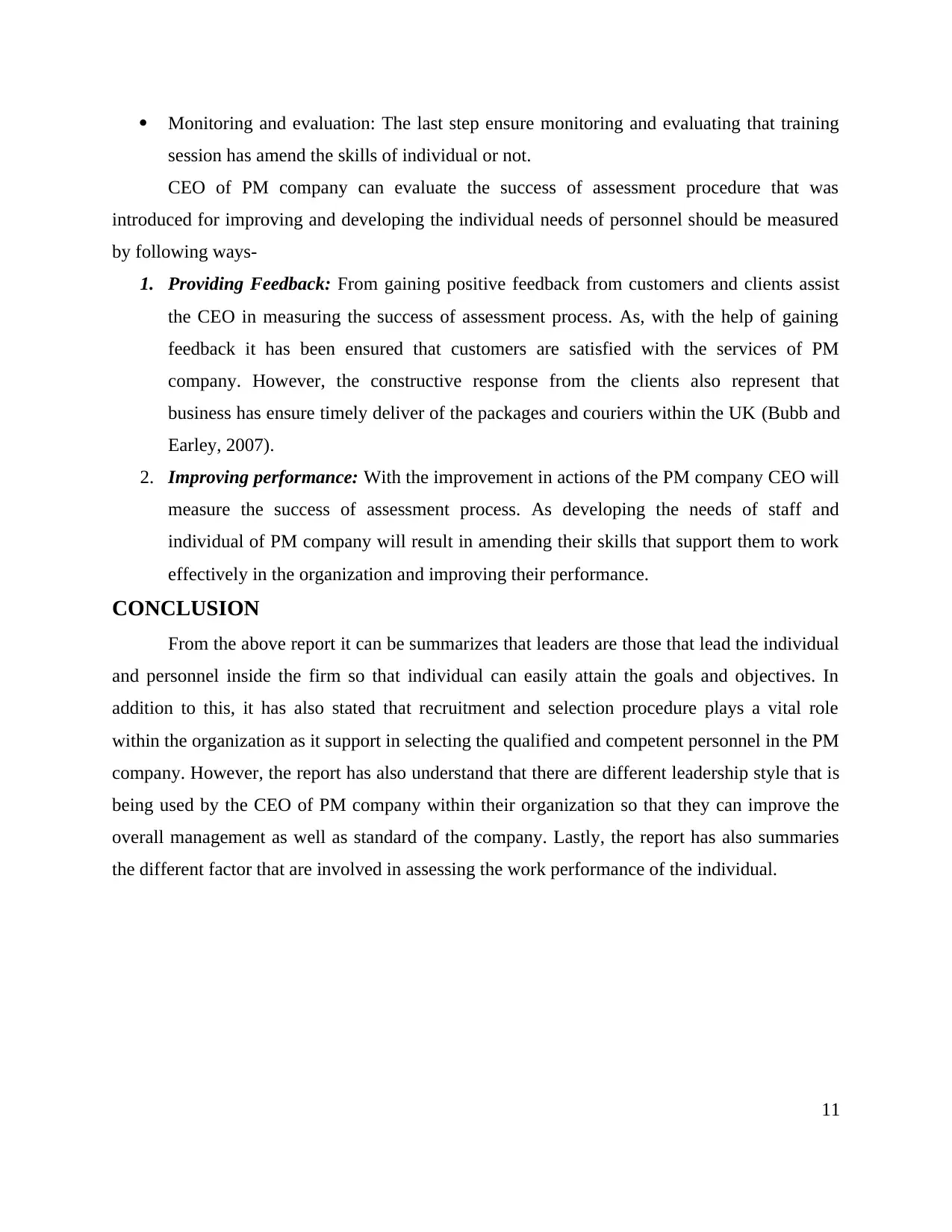
Monitoring and evaluation: The last step ensure monitoring and evaluating that training
session has amend the skills of individual or not.
CEO of PM company can evaluate the success of assessment procedure that was
introduced for improving and developing the individual needs of personnel should be measured
by following ways-
1. Providing Feedback: From gaining positive feedback from customers and clients assist
the CEO in measuring the success of assessment process. As, with the help of gaining
feedback it has been ensured that customers are satisfied with the services of PM
company. However, the constructive response from the clients also represent that
business has ensure timely deliver of the packages and couriers within the UK (Bubb and
Earley, 2007).
2. Improving performance: With the improvement in actions of the PM company CEO will
measure the success of assessment process. As developing the needs of staff and
individual of PM company will result in amending their skills that support them to work
effectively in the organization and improving their performance.
CONCLUSION
From the above report it can be summarizes that leaders are those that lead the individual
and personnel inside the firm so that individual can easily attain the goals and objectives. In
addition to this, it has also stated that recruitment and selection procedure plays a vital role
within the organization as it support in selecting the qualified and competent personnel in the PM
company. However, the report has also understand that there are different leadership style that is
being used by the CEO of PM company within their organization so that they can improve the
overall management as well as standard of the company. Lastly, the report has also summaries
the different factor that are involved in assessing the work performance of the individual.
11
session has amend the skills of individual or not.
CEO of PM company can evaluate the success of assessment procedure that was
introduced for improving and developing the individual needs of personnel should be measured
by following ways-
1. Providing Feedback: From gaining positive feedback from customers and clients assist
the CEO in measuring the success of assessment process. As, with the help of gaining
feedback it has been ensured that customers are satisfied with the services of PM
company. However, the constructive response from the clients also represent that
business has ensure timely deliver of the packages and couriers within the UK (Bubb and
Earley, 2007).
2. Improving performance: With the improvement in actions of the PM company CEO will
measure the success of assessment process. As developing the needs of staff and
individual of PM company will result in amending their skills that support them to work
effectively in the organization and improving their performance.
CONCLUSION
From the above report it can be summarizes that leaders are those that lead the individual
and personnel inside the firm so that individual can easily attain the goals and objectives. In
addition to this, it has also stated that recruitment and selection procedure plays a vital role
within the organization as it support in selecting the qualified and competent personnel in the PM
company. However, the report has also understand that there are different leadership style that is
being used by the CEO of PM company within their organization so that they can improve the
overall management as well as standard of the company. Lastly, the report has also summaries
the different factor that are involved in assessing the work performance of the individual.
11
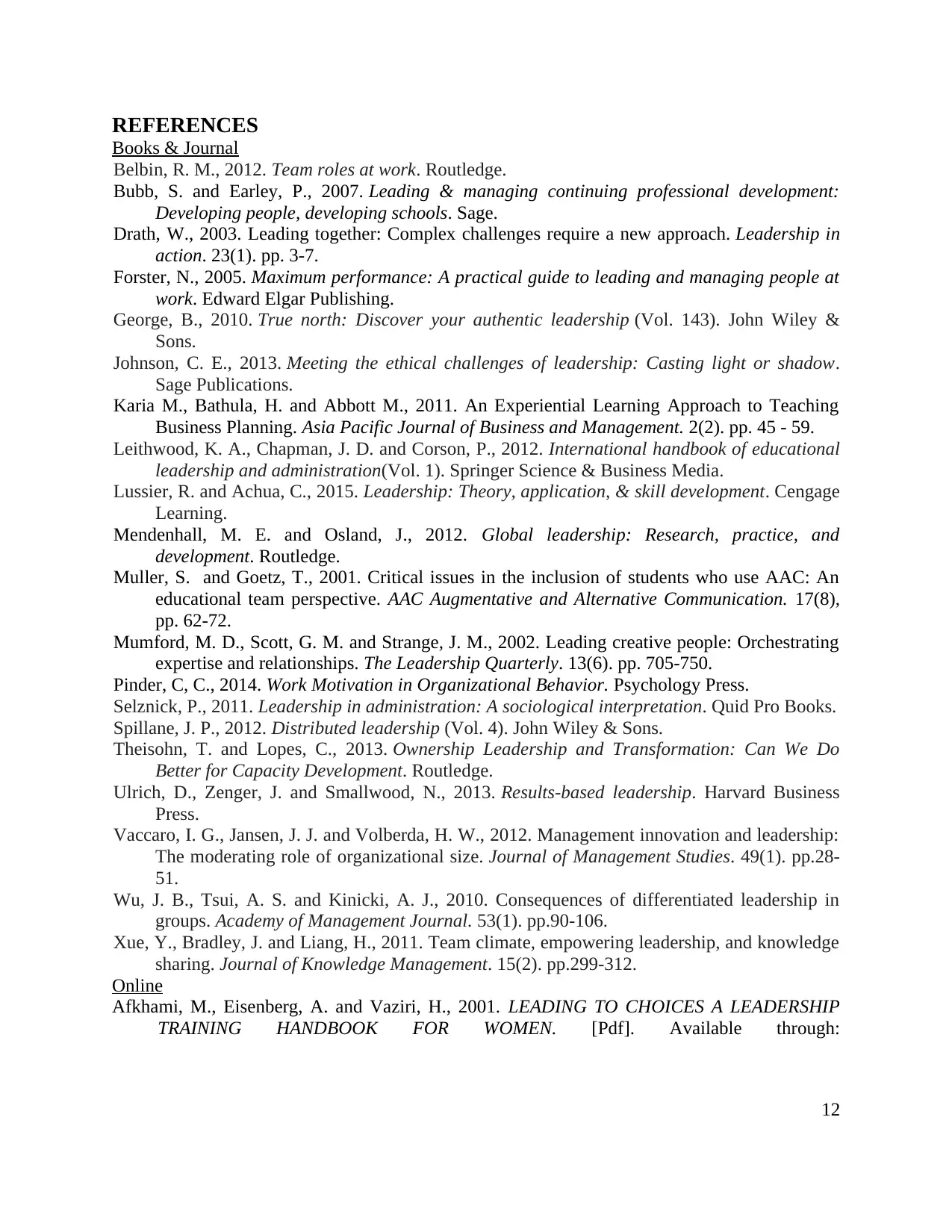
REFERENCES
Books & Journal
Belbin, R. M., 2012. Team roles at work. Routledge.
Bubb, S. and Earley, P., 2007. Leading & managing continuing professional development:
Developing people, developing schools. Sage.
Drath, W., 2003. Leading together: Complex challenges require a new approach. Leadership in
action. 23(1). pp. 3-7.
Forster, N., 2005. Maximum performance: A practical guide to leading and managing people at
work. Edward Elgar Publishing.
George, B., 2010. True north: Discover your authentic leadership (Vol. 143). John Wiley &
Sons.
Johnson, C. E., 2013. Meeting the ethical challenges of leadership: Casting light or shadow.
Sage Publications.
Karia M., Bathula, H. and Abbott M., 2011. An Experiential Learning Approach to Teaching
Business Planning. Asia Pacific Journal of Business and Management. 2(2). pp. 45 - 59.
Leithwood, K. A., Chapman, J. D. and Corson, P., 2012. International handbook of educational
leadership and administration(Vol. 1). Springer Science & Business Media.
Lussier, R. and Achua, C., 2015. Leadership: Theory, application, & skill development. Cengage
Learning.
Mendenhall, M. E. and Osland, J., 2012. Global leadership: Research, practice, and
development. Routledge.
Muller, S. and Goetz, T., 2001. Critical issues in the inclusion of students who use AAC: An
educational team perspective. AAC Augmentative and Alternative Communication. 17(8),
pp. 62-72.
Mumford, M. D., Scott, G. M. and Strange, J. M., 2002. Leading creative people: Orchestrating
expertise and relationships. The Leadership Quarterly. 13(6). pp. 705-750.
Pinder, C, C., 2014. Work Motivation in Organizational Behavior. Psychology Press.
Selznick, P., 2011. Leadership in administration: A sociological interpretation. Quid Pro Books.
Spillane, J. P., 2012. Distributed leadership (Vol. 4). John Wiley & Sons.
Theisohn, T. and Lopes, C., 2013. Ownership Leadership and Transformation: Can We Do
Better for Capacity Development. Routledge.
Ulrich, D., Zenger, J. and Smallwood, N., 2013. Results-based leadership. Harvard Business
Press.
Vaccaro, I. G., Jansen, J. J. and Volberda, H. W., 2012. Management innovation and leadership:
The moderating role of organizational size. Journal of Management Studies. 49(1). pp.28-
51.
Wu, J. B., Tsui, A. S. and Kinicki, A. J., 2010. Consequences of differentiated leadership in
groups. Academy of Management Journal. 53(1). pp.90-106.
Xue, Y., Bradley, J. and Liang, H., 2011. Team climate, empowering leadership, and knowledge
sharing. Journal of Knowledge Management. 15(2). pp.299-312.
Online
Afkhami, M., Eisenberg, A. and Vaziri, H., 2001. LEADING TO CHOICES A LEADERSHIP
TRAINING HANDBOOK FOR WOMEN. [Pdf]. Available through:
12
Books & Journal
Belbin, R. M., 2012. Team roles at work. Routledge.
Bubb, S. and Earley, P., 2007. Leading & managing continuing professional development:
Developing people, developing schools. Sage.
Drath, W., 2003. Leading together: Complex challenges require a new approach. Leadership in
action. 23(1). pp. 3-7.
Forster, N., 2005. Maximum performance: A practical guide to leading and managing people at
work. Edward Elgar Publishing.
George, B., 2010. True north: Discover your authentic leadership (Vol. 143). John Wiley &
Sons.
Johnson, C. E., 2013. Meeting the ethical challenges of leadership: Casting light or shadow.
Sage Publications.
Karia M., Bathula, H. and Abbott M., 2011. An Experiential Learning Approach to Teaching
Business Planning. Asia Pacific Journal of Business and Management. 2(2). pp. 45 - 59.
Leithwood, K. A., Chapman, J. D. and Corson, P., 2012. International handbook of educational
leadership and administration(Vol. 1). Springer Science & Business Media.
Lussier, R. and Achua, C., 2015. Leadership: Theory, application, & skill development. Cengage
Learning.
Mendenhall, M. E. and Osland, J., 2012. Global leadership: Research, practice, and
development. Routledge.
Muller, S. and Goetz, T., 2001. Critical issues in the inclusion of students who use AAC: An
educational team perspective. AAC Augmentative and Alternative Communication. 17(8),
pp. 62-72.
Mumford, M. D., Scott, G. M. and Strange, J. M., 2002. Leading creative people: Orchestrating
expertise and relationships. The Leadership Quarterly. 13(6). pp. 705-750.
Pinder, C, C., 2014. Work Motivation in Organizational Behavior. Psychology Press.
Selznick, P., 2011. Leadership in administration: A sociological interpretation. Quid Pro Books.
Spillane, J. P., 2012. Distributed leadership (Vol. 4). John Wiley & Sons.
Theisohn, T. and Lopes, C., 2013. Ownership Leadership and Transformation: Can We Do
Better for Capacity Development. Routledge.
Ulrich, D., Zenger, J. and Smallwood, N., 2013. Results-based leadership. Harvard Business
Press.
Vaccaro, I. G., Jansen, J. J. and Volberda, H. W., 2012. Management innovation and leadership:
The moderating role of organizational size. Journal of Management Studies. 49(1). pp.28-
51.
Wu, J. B., Tsui, A. S. and Kinicki, A. J., 2010. Consequences of differentiated leadership in
groups. Academy of Management Journal. 53(1). pp.90-106.
Xue, Y., Bradley, J. and Liang, H., 2011. Team climate, empowering leadership, and knowledge
sharing. Journal of Knowledge Management. 15(2). pp.299-312.
Online
Afkhami, M., Eisenberg, A. and Vaziri, H., 2001. LEADING TO CHOICES A LEADERSHIP
TRAINING HANDBOOK FOR WOMEN. [Pdf]. Available through:
12
⊘ This is a preview!⊘
Do you want full access?
Subscribe today to unlock all pages.

Trusted by 1+ million students worldwide
1 out of 13
Related Documents
Your All-in-One AI-Powered Toolkit for Academic Success.
+13062052269
info@desklib.com
Available 24*7 on WhatsApp / Email
![[object Object]](/_next/static/media/star-bottom.7253800d.svg)
Unlock your academic potential
Copyright © 2020–2025 A2Z Services. All Rights Reserved. Developed and managed by ZUCOL.





